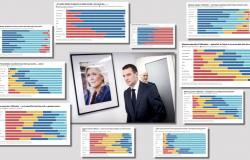
the essential
The G7 countries intend to grant a megaloan of 50 billion euros to Ukraine thanks to the interest generated by Russian assets which have been frozen by the West. Explanations.
“Good news from the G7: 50 billion dollars more for Ukraine,” German Finance Minister Christian Lindner wrote on X. According to Paris, an agreement in principle has already been concluded “on the disbursement of 50 billion” dollars “before the end of 2024”.
Gute Nachrichten von den G7: Weitere 50 Billion Dollar für die Ukraine. Dafür nutzen wir Zinsen aus eingefrorenen Vermögenswerten – ein smartes Instrument, das Putin unsere Einigkeit zeigt, der Ukraine stark hilft und die Haushalte entlastet. Please refer to the details. CL
— Christian Lindner (@c_lindner) https://twitter.com/c_lindner/status/1801186846023483822?ref_src=twsrc%5Etfw
Where will these 50 billion euros come from?
The European Union and the G7 countries have agreed to seize income from Russian assets frozen by the West since the start of the conflict in Ukraine. In the EU alone, this represents a windfall of 2.5 to 3 billion euros per year. Enough to finance the 50 billion loan granted to Ukraine. This loan “is essentially American”, but “can be supplemented with European money or national contributions”, indicated the French presidency.
After advocating a pure and simple confiscation of Russian assets, the United States has now aligned itself with the European position of using only the interest generated by the frozen assets.
What amounts are we talking about?
The European Union and G7 countries have frozen some 300 billion euros in assets of Russia’s central bank, according to the EU. They also seized private assets of people linked to Russian power.
According to the Institute of Legislative Ideas, a Ukrainian think tank which claims to question official sources, $397 billion is tied up. The World Bank, for its part, estimates the cost of rebuilding Ukraine at more than $486 billion.
Where is the money ?
Especially in the European Union: around 185 billion euros were frozen by Euroclear, an international fund deposit organization established in Belgium. This gives preponderant weight to Europe over the use of Russian assets. The rest is mainly shared between the United States, Japan, the United Kingdom, Austria and Switzerland.
Unanswered questions?
However, many questions persist regarding the G7 loan guaranteed by the interests of Russian assets, such as the sharing of risk between the United States and Europe or the unknown evolution of interest rates. According to White House national security adviser Jake Sullivan, delegations are still working out the details, including the financial mechanism used. “The main lines have been decided, but certain details still need to be clarified by the experts on a precise timetable,” he said on Thursday.
Another pitfall, Japan’s hands are tied by its constitution which prohibits it from financing the military spending of third countries, which would limit a loan to kyiv’s budgetary needs only.
What are the risks ?
EU sanctions imposed on Russia, including the immobilization of Russian assets, must be renewed every six months by a unanimous vote of the Council. A possible veto by Hungarian nationalist Prime Minister Viktor Orban, who remains close to the Kremlin, could therefore block the mechanism, especially since Hungary will assume responsibility on 1er July the presidency of the European Union.
And what will happen if the assets are released?
G7 finance ministers reaffirmed that Moscow’s assets “will remain tied up until Russia pays for the damage it has caused to Ukraine.” Hence the prospect that Russian assets can generate profits for a long time to come.
Some also worry about an impact on investments from third countries, such as China, which could reduce their assets in Western countries for fear of them being seized.
And Russia is threatening retaliation against Western private interests. Vladimir Putin signed a decree at the end of May authorizing the confiscation in Russia of assets belonging to the United States or to people “associated” with them.





